Follow along and explore the hard evidence of debris, debris patterns, and video of collapse. This is the type evidence which will be presented to a grand jury if there were to be a new investigation. Those who claim controlled demolition brought down WTC7 have to overcome this evidence with structural evidence of CD in order to open a new investigation. My research finds the Structural remains of Building 7 show no sign of controlled demolition.
____________________________________________________________________________________________
Before delving into the structural evidence, it is important to know about this fatal damage to the south face of Building 7. Watch this brief clip:
Haven’t seen this before? How did it get there? Be sure to follow this blog for those answers. This chapter establishes that indeed, Building 7 was slashed top to near bottom on the south face:
Photo by Tom Franklin 9/11/01:
When I first noticed this dark vertical line on the south face of WTC7, like most observers, I dismissed it as a shadow, or other building feature. Veiled in smoke, and because of it’s even shape, it was easy to overlook. Further study several years later revealed it to be a fatal breach, largely responsible for building failure.
(Click on photos for enlargement)
This photo shows gash from top down 7 floors. It actually begins as a gouge:
A close-up of the top reveals more. Enlarge for detail:
Middle portion:
The next photo I believe shows the lower portion of the gash. I cannot be positive of the column locations, but it appears to me the southwest corner of WTC7 is right at the corner of the white building on the left, which is Verizon Building. That would make the damage shown here indeed the bottom area of the gash, and part of the central hole described by firemen, who could see only parts of it due to the smoke.
Debris corroboration:
A comparison with the Bankers Trust Building:
A composite of the above photos:
The reason the line of the gash is cleanly vertical is because the piece of perimeter wall which did this damage was cradled between two columns as it fell, much like the edge of a sword. The nature of damage indicates the plane of the falling perimeter wall struck flat or at an angle, then turned sideways, and turned back to flat near the bottom.
WTC7 perimeter wall, and a panel of WTC1 perimeter wall being lowered into place:
The lintel I-beams of WTC7 (horizontal piece between each column) were sandwiched between the columns, and were no match for the 50 or more tons of plummeting steel perimeter wall from WTC1. The only resistance was the welds on each end of the lintel. The WTC1 perimeter wall fell between two of those columns (photo is not the actual columns which were hit, but from the east wall).
The piece of perimeter wall from WTC1 which struck WTC7, based upon the width of the initial gouge at the top, was at least 2 panels wide when it struck, then turned sideways where the hole narrowed. Since it was falling at an arc, the fact it ripped through the wall down to at least the 23rd floor means it was longer than one panel.
Most of the falling wall panels from both towers were in units of 3 or more attached panels. Each panel weighed approximately 15 tons.
There is no question the south face of WTC7 was severed top to at least the 23rd floor, and likely to near the bottom. Those 24 floors of perimeter wall breach alone would be fatal for the building. NIST it seems, did not have this information when modeling collapse of WTC7, which makes their models moot, and is the source much confusion and distrust of the NIST report. Controlled demolition proponents claim south face damage was minimal. These photos show damage to the building was fatal. Integrity of the perimeter wall, or “curtain”, in a large span design, is vital for lateral and diagonal stability.
How the building collapsed (to be addressed in another chapter) confirms the south face breach. Note the NE part of the building is folding vertically toward the camera at onset, and continues as collapse progresses. There is more curvature of the north face near the top than lower, which means the SE corner was leaning toward the camera, but the west part of the building was resisting, trying to fall south.
An argument can be made the SE corner could fall to the north without there being a gash, since the roof truss was at this point destroyed. It could, but without a break in the perimeter wall curtain on the south side, it would force the SW corner to the west. Any direction of lean in the east sector of the building would have distorted the SW corner. No such distortion can be seen in the above photos. There had to be a breach of south face in order for the perimeter wall collapse to initiate as it did.
The sudden lean of the SE corner occurred as soon as the west penthouse kinked, or when the roof truss failed completely.
An overhead illustration of the roof at initiation:
The fold of the north face at initiation (of perimeter wall part of collapse) confirms the south face top down breach.
The logical next question is how the gash got there. Video evidence confirms a section of WTC1 indeed hit the top of WTC7 in the vicinity of column 20, covered in the next chapter, “WTC7 Gash – How It Got There”.
Video sources:

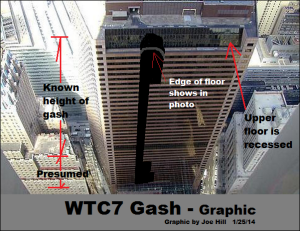
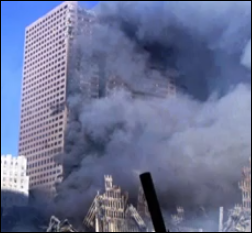
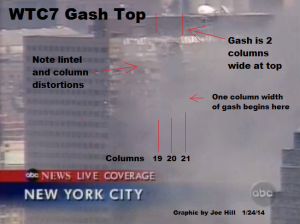
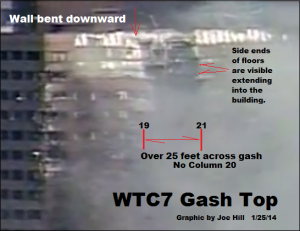
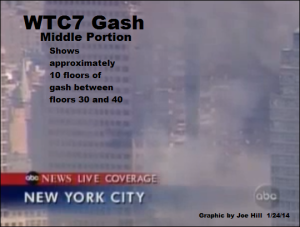
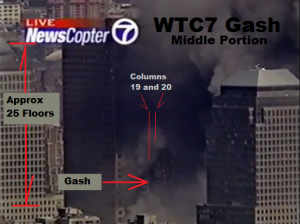
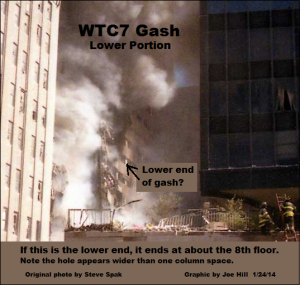
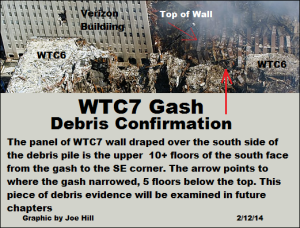
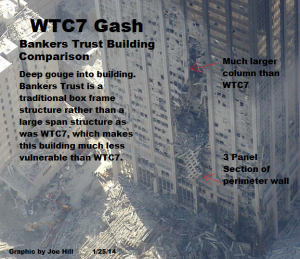
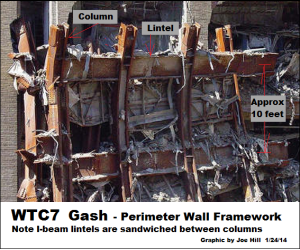
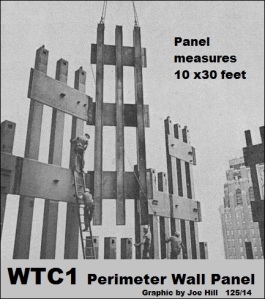
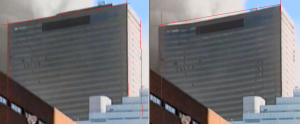
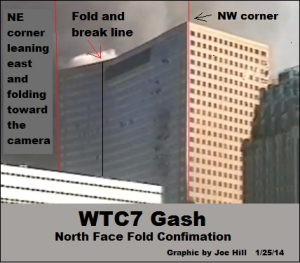
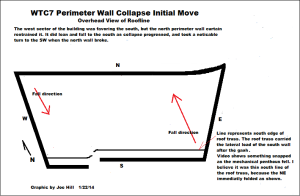
The more I look at the top of the gash, the more I believe it actually penetrated the roof line, or the falling perimeter wall struck deeper into the building than I depicted.
wow… didn’t get on the internet until 2008 … Impressive. Still waiting for the rationale that explains how inertial resistance in a rated steel structure can be explained in light of freefall velocity. WTC7 is a key in the events of the day. Why were there hotpsots recorded by FLIR for weeks after the events of the day ? So, bit of a web newbie… but you are fully conversant with the meme *crickets* ? If a top to bottom ‘gash’ is opened up in a building facade, the stress concentrations that this causes in an engineered structure will force gradual and directional loss of structural integrity. Not, as was filmed, the sudden, symetrical downwards progressive loss of integrity. Nice try, no cigar.
YOU NAILED IT Henry Balfour!
A top to bottom gash indeed would cause gradual load displacement, and that is exactly what happened. Did you study the perimeter wall initial move diagram above? The east half of the building was distorting to the north, and the west half was distorting south; early in the day. Video and debris evidence confirms it fell over in two directions, and there is plenty of other evidence to corroborate this displacement. Follow along and you will see Building 7 did not suddenly fall straight down, as the CD proponents would have you believe.
Joe Hill. Is that Hank Hills brother? Except he deals in kerosene instead of propane? So any building that loses one side falls down? What about the other four corners? Is it a quantum effect? One side gets a tear in it and it quantumly interferes with the other three sides?
ANY building? You reveal your lack of understanding. The Twin Towers and Building 7 were the only large span designed structures in existence. “Large Span” places a load on the perimeter walls not found in traditional box frame high rises. A box frame could be sliced top to bottom on one side and the building would stand. Not true for a large span. To understand, place the tube of a paper towel core on end and balance a brick or heavy book on it. The tube will support the brick just fine. Now cut a slit top to bottom in the tube, and replace the brick; it won’t stand.
But even worse than having the perimeter wall cut top to bottom, the falling North Tower perimeter wall actually sliced deep into Building 7, severing the cross ties of the core for about the bottom 2/3 of the building. This is confirmed by FDNY noting a bulge at the SW corner between floors 10 and 13, and the creaking noises observed by the inspection team, and the arc of the falling perimeter wall.
Your right I don’t understand. I guess I’m ignorant. Here’s a floor plan of the beams from NIST.
What do all those beams in the middle do? Maybe they hold up floor planters or maybe since the NY emergency operation center was there they wanted to hand maps on them. Anyways I notice the NIST FAQ doesn’t say anything about the gash causing the buildings destruction.
http://www.nist.gov/public_affairs/factsheet/wtc_qa_082108.cfm
But…wait…maybe they do! At the internet archive site it shows they changed that page. Yi Doggies!
https://web.archive.org/web/20100927011702/http://www.nist.gov/public_affairs/factsheet/wtc_qa_082108.cfm
A quote from the page,”…Did debris from the collapse of WTC 1 cause damage to WTC 7’s structure in a way that contributed to the building’s collapse?
The debris caused structural damage to the southwest region of the building-severing seven exterior columns-but this structural damage did not initiate the collapse. ..”
Damn. I guess I’m back to my quantum collapse theory. Maybe we’ll find out more if the detailed investigation of the collapse of building #7 initiative passes in NY city. Hope so.
All those beams in the middle were severed near column 69.
NIST did not know about nor did it model the actual damage, so their conclusions are moot. Indeed, losing the lower portion of 7 perimeter columns in the SW area would not cause the building to collapse. They did not factor in the gash.
“…NIST did not know about nor did it model the actual damage…”
??? Then what was all that modeling they did? If they don’t know, how do you?
Maybe you’re right since they hauled off all the material and melted it down before anyone could have a good look at it.
Sam, I’ve illustrated the damage in this blog. Video shows the damage and shows the falling perimeter wall which sliced into Building 7. You’ll have to ask NIST why they did not factor in this damage. I found it because I looked for myself, instead of relying on sites such as AE911Truth; they don’t even show the south face of the building, showing only the upwind north face. You can’t get the truth there.
And regardless of what happened to all the structural remains, there is plenty of photo and video evidence, all taken day of and after, which can be studied. Every bit of it tells the story of how the buildings came down, and there is not one shred of controlled demolition evidence in any of it.
NIST knew about it. I have seen a map released by NIST showing the damage created by the falling debris of WTC1. I recall that according to NIST, 5 perimeter columns and 3 core columns were affected by the falling debris. But indeed, they did not take that into account in their modeling of the collapse. To understand why they didn’t, you have to look at the objective of the NIST investigation. Their objective was to find out if and in what way the building construction and used materials played a role in the initiation of the global collapse of the tower.
The tower collapse started in the eastern part of the building, which wasn’t damaged by the falling debris. So NIST investigated if a local failure of the structure in the eastern part of the building would initiate a global collapse. And as their simulation reveals, it did.
What NIST has proven in their report is that even without the damage caused by wtc1 and even without the possibility of diesel fuel added to the fires, the building would have collapsed completely due to 1 column failure in the eastern part of the building.
And that is all that is important for them to make recommendations for new building rules to avoid future structures similar to the design of WTC7 to experience the same fatal weakness in a fire.
Sam, it’s entirely possible to challenge somebody’s theory and question this bit of evidence or that without being a smug, sarcastic, condescending asshole.
Hi,
in your lower gash picture your arrow seems to point to what I highlighted in red here:
http://s1379.photobucket.com/user/Zett-eL/media/lowergash_zpsirpsd8kk.jpg.html?sort=3&o=0
However, what I highlighted in green looks more like a gash, doesn´t it? Then we´d have no end of gash there.
At least if we consider as part of WTC7 what I highlighted here:
http://s1379.photobucket.com/user/Zett-eL/media/lowergash2_zpsw9gtgih6.jpg.html?sort=3&o=1
Probably its the edge of the (or a) gash, but I wonder if it could instead be a part of WTC1 core structure, hanging or leaning there. Its angle seems to match almost, but not perfectly with the other WTC7 columns and it just looks different then the rest of WTC7. Then again it doesn´t seem to match up with anything we can see falling on WTC7…
What you think?
I believe the part you highlight in green is actually the corner of wtc7. Which got also damaged by falling debris.
Sorry to take so long to reply Zett eL. I ebb and flow with this, and hadn’t been around in a while.
I was thinking what you are highlighting could be a sign post. https://s6.postimg.io/f4lp773gh/Spak_Vessey_ST7.png
The arrow furthest down the street points to the same piece you highlighted? The closer one shows another sign post closer up. It’s the only thing sticking straight up in this shot. But I don’t know. It looks like it could be a column from 7 that got jostled around and stripped. What you circled in green, the white smoke area, I believe is the bottom of the main gash. What you circled in red could be from another piece of perimeter wall. The spire did break apart shortly before impact, sending part of it slightly east of the main piece. These photos don’t give a lot to go on for the lower section of the gash. But it’s not a North Tower core column without some concrete evidence it is.
North Tower core didn’t fall toward 7WTC. Not much of the east side of core collapse is recorded, but the core was split north/south by the top north wall, and splayed apart east/west; that we know. https://s6.postimg.io/4rfgz8k1t/WTC1standingcore2.png . What we could see of the east core collapsing fell east. We also know the west half fell west/south https://media.giphy.com/media/l41Yz6mkKo9qidQHe/giphy.gif . Anything that may have twisted apart and worked north wouldn’t have enough mass to do much damage, and very doubtful any of it could reach 7 if it did.
The depth of the gash into 7WTC footprint can be in part gauged by the elevator out of it’s shaft and down the hall. West service elevator bank is dead in line with the gash. The falling spire tangled with elevator cables on the way down. That bank of two shafts is toward the south edge of the core, so we know it went that deep minimum, and falling arc analysis confirm it, actually showing it went deeper.
Keep in mind. The entry hole at the top is 20+ feet into the footprint, and the spire is arcing into the structure. That we know as fact.
I changed my opinion. Now I think it probably IS part of WTC1 core structure. I even think I identified that sucker in WTC1 collapse videos.
I dont think it entered WTC7 as deep as you suggest.
This explanation that the gash in WTC7 (in between columns 18 and 21, by the looks of it) is contradictory to the NIST report that states that it was the collapse of column 79 which initiated the chain of events that brought down the structure. If your rebuttal is that NIST was wrong and didn’t know about the gash, then I wouldn’t trust anything else they reported on either..
NIST failed to accurately assess damage, for whatever reason. The collapse of column(s) 79, 80, and 81 (I suspect they all three buckled about the same time) is obviously where column collapse initiated. But that is just column collapse. It was floor collapse that left 79 unsupported horizontally, and there is evidence floor collapse initiated in the same area of the building that suffered the gash, near column 54 on the north face. Floor collapse of 2 or more floors around column 79 would certainly cause it to buckle. Structural evidence, however, indicates floor trusses broke from the perimeter walls, but remained attached to core columns. That would suggest the falling floors snatched column 79 apart as they fell.
To the best of my knowledge, I have never used NIST as a reference to make a point. I use only publicly available evidence to support factual conclusions. The fact NIST erred in one area is no indication they erred in all areas. Each part of collapse, and NIST findings, have to be assessed separately.
Thanks for your comment. I haven’t been attending to this blog of late, and didn’t know any one was reading it. My intent is to totally redo it with mostly videos sometime soon.
No, The gash is also visible in the NIST plan showing the damage of wtc7. NIST however concluded that the collapse initiation happened with the failure of column 79.
NIST did not, to the best of my knowledge, incorporate the top to near bottom gash, nor it’s entry hole at the top. Since I’ve never used NIST as a reference, I can’t be absolutely sure, but I’ve seen some of their damage assessments, and those are not included in what I’ve seen. They did note a 20 story hole and several perimeter columns breached on the lower south face. A 20 story hole would not destroy lateral and diagonal stability; top to near bottom would, and cause load shift in the entire structure, thus the creaking girders and bulge in the SW corner. Additionally, lower core cross girders severed would provide the route for expansion/contraction to do it’s damage; much less likely with an intact horizontal structure. And again, also missed by NIST, is evidence that floor collapse actually started in the same quadrant of the building as the gash damage (sudden dust cloud and flash fire at column 54 2 minutes prior to east penthouse descent). Indeed, collapse of vertical members initiated at column 79, and likely 80 and 81.
Since the global collapse initiation started in the eastern part of the tower, NIST did not incorporate the damage to the south wall in their findings.
+Whatever
“Global collapse” initiated with the first thing to collapse, that being floors, with evidence suggesting it was in the west quadrant. Collapse of vertical structural elements indeed started with column 79 and possibly 80 and 81. Had damage been assessed and accounted for, it would likely show floor collapse started in the area of the gash, and progressed around the north span to the east. It would also show the structure had shifted center of gravity with two “halves” leaning into one another, and produce a much more accurate model of what we can see of the shell collapsing.
Indeed, if NIST incorporated the south wall damage into their analysis, they would have presented a more accurate model of how wtc7 collapsed and that would most likely have silenced more people who believe wtc7 could not have collapsed that way.
However, the goal of NIST was to determine if and how the construction and used materials incorporated in the global collapse initiation. And NIST concluded that even if the tower had ‘normal office fires’ in the eastern, it would have collapsed.
And that is very important conclusion, because it implies that the design of the tower was flawed and that other towers designed in a similar way are subjected to possible collapses if they have uncontrolled fires burning.
AFAIK NIST did recommend to reinforce structures of similar buildings to address this issue.